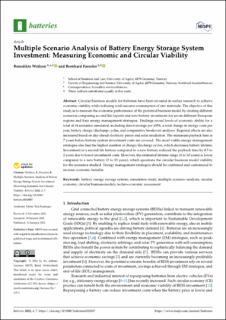| dc.contributor.author | Wrålsen, Benedikte | |
| dc.contributor.author | Faessler, Bernhard | |
| dc.date.accessioned | 2023-04-18T08:05:11Z | |
| dc.date.available | 2023-04-18T08:05:11Z | |
| dc.date.created | 2022-01-21T18:04:39Z | |
| dc.date.issued | 2022 | |
| dc.identifier.citation | Wrålsen, B. & Faessler, B. (2022). Multiple Scenario Analysis of Battery Energy Storage System Investment : Measuring Economic and Circular Viability. Batteries, 8(2): 7. | en_US |
| dc.identifier.issn | 2313-0105 | |
| dc.identifier.uri | https://hdl.handle.net/11250/3063479 | |
| dc.description.abstract | Circular business models for batteries have been revealed in earlier research to achieve economic viability while reducing total resource consumption of raw materials. The objective of this study is to measure the economic performance of the preferred business model by creating different scenarios comparing second life (spent) and new battery investment for seven different European regions and four energy management strategies. Findings reveal levels of economic ability for a total of 34 scenarios simulated, including direct savings per kWh, a total change in energy costs per year, battery charge/discharge cycles, and comparative breakeven analyses. Regional effects are also measured based on day-ahead electricity prices and solar irradiation. The minimum payback time is 7 years before battery system investment costs are covered. The most viable energy management strategies also had the highest number of charge/discharge cycles, which decreases battery lifetime. Investment in a second life battery compared to a new battery reduced the payback time by 0.5 to 2 years due to lower investment costs. However, the estimated lifetime range (3 to 10 years) is lower compared to a new battery (5 to 15 years), which questions the circular business model viability for the scenarios studied. Energy management strategies should be combined and customized to increase economic benefits. | en_US |
| dc.language.iso | eng | en_US |
| dc.publisher | MDPI | en_US |
| dc.rights | Navngivelse 4.0 Internasjonal | * |
| dc.rights.uri | http://creativecommons.org/licenses/by/4.0/deed.no | * |
| dc.title | Multiple scenario analysis of battery energy storage system investment : measuring economic and circular viability | en_US |
| dc.type | Journal article | en_US |
| dc.type | Peer reviewed | en_US |
| dc.description.version | publishedVersion | en_US |
| dc.rights.holder | © 2022 The Author(s) | en_US |
| dc.subject.nsi | VDP::Teknologi: 500 | en_US |
| dc.source.pagenumber | 17 | en_US |
| dc.source.volume | 8 | en_US |
| dc.source.journal | Batteries | en_US |
| dc.source.issue | 2 | en_US |
| dc.identifier.doi | https://doi.org/10.3390/batteries8020007 | |
| dc.identifier.cristin | 1987636 | |
| dc.relation.project | Norges forskningsråd: 321111 | en_US |
| dc.relation.project | Norges forskningsråd: 99334 | en_US |
| cristin.qualitycode | 1 | |

